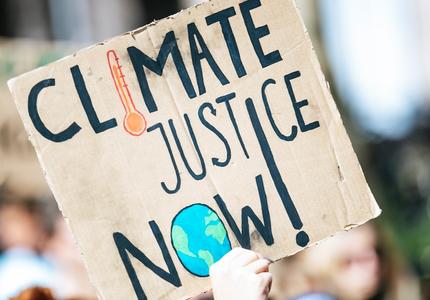On December 12, 2015, 195 countries unanimously adopted the Paris Agreement, the first climate change treaty build upon universal rules, widely heralded as a historic success in the multilateral fight against the climate crisis. The Agreement’s five-year anniversary is naturally a moment to reflect on what has been achieved to date—and what has not yet been tackled yet—in the past five years. It also is a moment to welcome the (mostly) new commitments by 75 countries and Non-State Actors (NSA) at the UN Climate Ambition Summit on Saturday, December 12. Most importantly, the Summit was the starting point of a critical buffer year up to COP26, which was delayed by a year due to the COVID-19 pandemic. In the upcoming eleven months, countries will need to demonstrate, both individually and collectively, that they can substantially accelerate short-term action so that the vision of a carbon neutral and resilient world by mid-century not only remains a possibility but becomes a reality.
Trump’s announcement that the United States would leave the Paris Agreement, the rise of nationalisms and geopolitical tensions caused the euphoric mood that reigned at the adoption of the Paris Agreement to quickly fade. Yet five years later, there is room for cautious hope: while climate mitigation is still far behind what is needed to address the crisis, the Paris Agreement has undoubtedly brought about major changes. One significant change is the shift in the global climate conversation from ‘reducing GHG emissions’ to racing toward carbon neutrality: By inscribing in Article 4.1 the objective to reach net-zero emissions in order to stabilise global temperature increase at 1.5ºC, the Paris Agreement made carbon neutrality a collective aspiration, although it was not yet articulated as a political objective. Five years later, the recent wave of mid-century carbon neutrality targets places the Agreement’s 1.5°C goal within striking distance—global warming by 2100 could be as low as 2.1°C if all the carbon neutrality pledges as of November 2020 are implemented.1 The carbon neutrality targets set by more than 100 countries, including new ones such as Argenting, and over 1,000 NSA set a clear horizon of radical transformation of economies and business models, industrial re-deployment, and reconversion, thereby creating converging anticipations and expectations. The key challenge now is to speed up implementation and build a consistent pathway towards net-zero emission by mid-century: the 1.5ºC goal will remain attainable if and only if these long-term neutrality goals are translated into immediate plans and actions.
The Climate Ambition Summit which just took place to commemorate the five-year anniversary of the Paris Agreement was the highlight of 2020 on climate mobilisation. It succeeded in demonstrating that the climate crisis had not been wiped from governmental agendas and remained a priority. But this event was mainly about generating the momentum which needs to be sustained until next November when the world meets in Glasgow. This is, in substance, what COP26 President Alok Sharma said in conclusion of the virtual summit, underscoring the immense role of the presidency—as demonstrated by France in 2015—and the expectations placed on the entire British government and its diplomacy. He pledged to use the G7 and the G20 fora to make headway on climate policy and carry out progress on all fronts. In order to succeed in demonstrating at COP26 that a tipping point has been passed, turning a vision of carbon neutrality into reality, the incoming Presidency will need the support of the the EU, China with concrete steps towards carbon neutrality, renewed leadership by the US, multilateral financial institutions and all progressive forces in every country.
Below are five challenges that will need to be addressed throughout the upcoming year to ensure COP26 is the stepping stone towards a carbon neutral and resilient future:
1. Green recovery, the pathway to carbon neutrality
COP26 is the moment where countries as well as corporations, cities and others must each be expected, under international public scrutiny, to convert their ‘carbon neutrality by mid-century’ announcements from a vision to a reality. The first step is to demonstrate this responsibility through their recovery plans this year, as they risk locking-in the high-carbon sectors and practices the transition aims to phase out. Mobilisation until Glasgow should work to ensure countries provide credible pathways to carbon neutrality, through the following elements: (1) an enhanced NDC, that jumpstarts the transformation to carbon neutrality over the key 2020-2030 decade, and closes the current ambition gap, and (2) a long-term strategy under the form of an LT-LEDS (Long-term Low Emissions and Development Strategies which the Paris Agreement invites Parties to submit in 2020) which provides as detailed a sectoral pathway to carbon neutrality as soon as possible. Obviously, COVID-19 recovery plans will need to demonstrate that immediate and short-term actions are consistent with the promised long-term decarbonisation. Confirmations by major economies of their intent to reach net-zero have been good signals, incremental steps in their increased ambition, but still need translating into major economic decisions. The EU just did so in raising its 2030 goal from -40% to more than 55%. China announced an additional reduction of its carbon intensity. The reality of the US recovery plan next year or of the Chinese 14th five-year plan will give critical indications.
2. Accelerating sectoral shifts and the increased (political) action by NSA
The orchestration, in the run-up to COP21, of a broad set of NSA demonstrating together that acting ambitiously on climate is not only feasible but also desirable, and calling on governments to act accordingly, was essential in ensuring the negotiation of an ambitious outcome in Paris. Together, these actors built a convincing narrative about a better future and reassured Parties that societies overall were ready for an ambitious climate agreement. Since 2015, climate momentum by NSA has accelerated significantly, with over 1,100 companies, 450 cities and 22 regions making net-zero commitments to date. However, reaching carbon neutrality by 2050 requires an even greater transformation across all sectors, and while the Paris Agreement’s Transparency Framework only tracks Parties’ progress towards their commitments, NSA also need to be held accountable to implementing the commitments they take on, even if voluntarily.
Therefore, in advance of COP26, there is a need for (1) radical collaboration to bring the needed sectoral climate ambition, especially in hard-to-abate sectors (such as coal phase-out), and (2) NSA to present clear plans to reach carbon neutrality, and start being held accountable, and (3) NSA to articulate specific political demands to governments which would enable greater climate action—demands such as legislative frameworks, financial regulations, international trade rules, fiscal incentives, procurement rules. By acting more ambitiously, NSA can in turn empower politicians and officials to take on even more ambitious pledges, and drive a faster transition towards a low-carbon and resilient society.
3. Accessing climate finance to avoid derailing COP26
Announcements on additional climate finance for the global South have been rather timid last Saturday, far from meeting the expectations, as COP26 President Alok Sharma pointed out in conclusion, indicating that this will remain a critical point of attention ahead of COP26. Five years after Paris, in the context of enhancing collective ambition, the question of growing support will be required to avoid several pitfalls, including: (1) 100 USD billion mobilization goal: as the pathway to achieving it becomes steeper, developed countries will need to reassure their developing country partners of their unwavering commitments to grow the volume of climate finance, by demonstrating that enhancing ambition also applies to support. The donor community should leverage the US comeback to mobilise other lagging contributors. (2) Green recovery plans and debt relief: will be essential, as there is a risk of over-indebtedness in developing countries that could prevent them from making a rapid transition. Ensuring that options exist for low-income countries to not be locked into high-carbon investments will require working with all multilateral and bilateral instruments so that they not only provide the necessary capital but that they manage to alleviate the debt burden.
4. Solidarity, justice, and resilience
Making the transition to carbon neutrality a reality requires to bring everyone along. Thus, the main demand of vulnerable nations concerns adaptation: it needs an equal footing with mitigation, to emphasise the need to enhance adaptive capacity, strengthen resilience and reduce vulnerability to climate change. The COVID-19 crisis has increased and will continue to increase social distress, vulnerability, and inequalities within and between countries. Enabling both post-COVID-19 reconstruction and low-carbon and climate resilient transformation at the same time is a challenge. Ramping up adaptation finance will be necessary to demonstrate additional solidarity and acknowledge the particular fate of the most vulnerable, by using public sources, dedicated channels and grant-like instruments. The crisis has also forced a redefinition of the concept of ‘just transition’, beyond the specific case of regions whose economy depends on fossil fuels, to address the whole range of justice issues linked to the social dimension of post-crisis reconstruction as an industrial redevelopment project at the scale of entire regions and sectors. This, with the objective not only to reduce greenhouse gases emissions, to be more resilient to climate change and its impacts, but also to shift towards an economic model that reduces inequalities and social vulnerability instead of increasing them. Concrete progress needs to be made in this direction throughout 2021, not just through finance but also concretely responding to vulnerable countries’ demands on political progress and attention on adaptation.
5. Coordinating climate and biodiversity ambitions towards carbon neutrality
Over the past year, the need to address climate change and biodiversity goals in a coordinated manner has entered the political and scientific mainstream. While 2021 is presented as a ‘nature and climate super year’ with climate COP26 and biodiversity COP15, misunderstandings remain about the opportunities and conditions for aligning climate and biodiversity ambitions, which may risk derailing COP26 if they create a counter-productive sense of competition between the two discussions. In order to avoid this, there are two key issues which must start being addressed in 2021: (1) ensure that pathways for implementing carbon neutrality targets take sufficiently ambitious GHG emissions reductions in the 2020-2030 decade, in order not to rely massively on the deployment of Carbon Dioxide Removal (CDR) measures in the land sector, which would compromise biodiversity and ecosystem integrity, and food security goals; (2) build on the political momentum for more coordinated climate and biodiversity ambition (the 2019 Beijing Call, the World Leaders’ Pledge for Nature that the UK COP26 Presidency is supporting, the two High Ambition Coalitions for climate and for nature) to ensure biodiversity integrity and carbon neutrality be better integrated in NDCs, LTSs and, even more importantly, in post COVID-19 recovery plans.
A difficult task now lies on the shoulders of the British COP26 presidency, and its allies, in addressing these five challenges, in order to ensure success in Glasgow and allow the next COP to set climate diplomacy on the path to achieving a carbon neutral and resilient future, thereby reaching the Paris promise.






